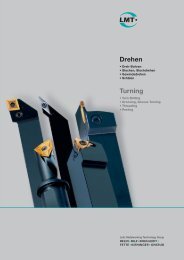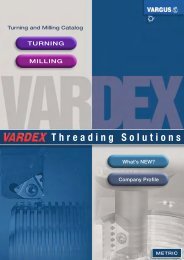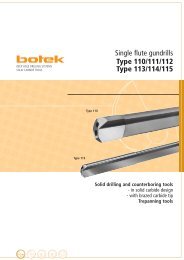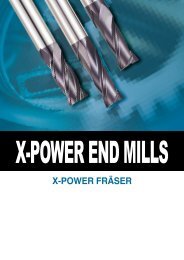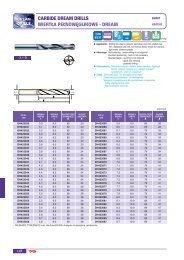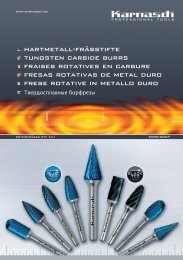Gear Cutting Tools
Hobs - Torion
Hobs - Torion
- No tags were found...
Create successful ePaper yourself
Turn your PDF publications into a flip-book with our unique Google optimized e-Paper software.
Machining with and<br />
without coolant<br />
The machining of steel materials<br />
generates considerable quantities<br />
of heat at the point of chip removal.<br />
If the temperatures reach<br />
excessive levels, the cutting edges<br />
of the tool are rapidly destroyed.<br />
In order to cool the tool and at the<br />
same time to lubricate the cutting<br />
edge, cooling lubricants have in<br />
the past been applied to the contact<br />
point between the cutting<br />
edge and the material to be machined.<br />
Cooling lubricants also<br />
have the function of flushing away<br />
the chips which are produced.<br />
Cooling lubricants, however, have<br />
considerable ecological, economic,<br />
and in many cases also technological<br />
disadvantages.<br />
Cooling lubricants present an ecological<br />
hazard since they impact<br />
the environment in the form of oil<br />
vapour and oil mist, and can<br />
present a health hazard to humans.<br />
Cooling lubricants are not economically<br />
justifiable, because they<br />
increase the production costs owing<br />
to the very high costs of their<br />
supply and disposal. Up to 16% of<br />
the total gear production costs can<br />
be saved by dry machining.<br />
Furthermore, cooling lubricants<br />
may pose disadvantages for technological<br />
reasons. The use of cooling<br />
lubricants in many hobbing operations<br />
involving carbide cutting<br />
edges, for example, may lead to<br />
premature failure of the tool owing<br />
to stress cracking (temperature<br />
shock). For this reason, cutting<br />
speeds are limited to 250 m/min<br />
for wet machining (in comparison<br />
with 350 to 450 m/min for dry machining).<br />
The table shows the advantages<br />
and disadvantages of<br />
cooling lubricant with regard to<br />
carbide hobbing.<br />
The main problem with dry machining<br />
lies in the increase in<br />
cutting temperature. Up to 80% of<br />
the heat which is generated is dissipated<br />
with the chips, provided<br />
attention has been paid to correct<br />
tool design and suitable cutting<br />
parameters are employed.<br />
The configuration of the tool is dependent<br />
upon the data of the gear<br />
to be manufactured. A significant<br />
influencing factor is the tip chip<br />
thickness, which is derived from<br />
the cutter design (number of<br />
starts, number of gashes, diameter),<br />
the workpiece geometry<br />
(module, number of teeth, cutting<br />
depth, helix angle) and the selected<br />
feed. An important consideration<br />
is that dry machining requires<br />
observance not only of an upper<br />
limit to the tip chip thickness, but<br />
also of a minimum thickness value.<br />
The greater the chip volume, the<br />
greater the quantity of heat which<br />
an individual chip can absorb. This<br />
must be taken into account in order<br />
to ensure that during dry machining,<br />
the greater part of the machining<br />
heat is dissipated by the<br />
chips.<br />
Advantages<br />
Disadvantages<br />
Machine ● Supports chip removal ● Aggregates (filters, pumps, etc.), therefore:<br />
● Lower heating up of the machine<br />
● Greater space requirements<br />
● Additional operating expenditure (maintenance,<br />
power, etc.)<br />
Tool ● Cooling of the tool ● Lower tool life owing to the formation of cracks<br />
perpendicular to the cutting edge (thermal shock)<br />
● Lubrication of the friction zones<br />
Workpiece ● Lower heating ● Cleaning necessary<br />
● Lower dimensional deviations<br />
● Protection against corrosion<br />
Environment ● Binding of graphite dust ● Health risk<br />
during cast iron machining<br />
Further costs ● Tempering of the workpiece, ● Purchasing costs<br />
thus faster measurement<br />
● Inventory costs<br />
Advantages and disadvantages of the use of cooling lubricant during hobbing<br />
● Contaminated chips, therefore:<br />
● Expensive recycling processes and<br />
● Higher disposal costs<br />
28



